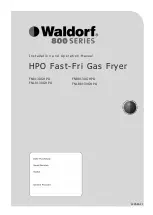
4
PREPARATION
1.
Sit the appliance on a stable, level, heat-resistant surface.
2.
Leave a space of at least 50mm all round the appliance.
3.
Position the appliance so that the basket handle doesn't extend up to or over the edge of the work
surface, where it is likely to be caught accidentally when passing.
4.
Unfold the basket handle and push the uprights over the latch above the hinge.
5.
Line a colander with kitchen paper, to drain the food after it's cooked.
ASSEMBLY
1.
Lower the bowl into the body of the fryer.
2.
Engage the grooves on the control unit with the guides on the rear of the body (FIG. A), and slide the
control unit into place (FIG. B).
If the control unit isn’t fitted correctly, a safety switch on the unit
will prevent the fryer from working
.
3.
Put the basket inside the bowl.
4.
Push the basket handle forward, and swing the handle down into the basket.
5.
Replace the lid.
FILLING
1.
Fill the bowl with good quality liquid cooking oil to between the MIN (2.7 litres) and MAX (3,2 litres)
marks on the side of the bowl.
2.
Don't use solid cooking oil, fat, butter or margarine.
3.
Don't mix oils of different types, as they will have different temperature characteristics.
4.
Replace the lid.
FOOD PREPARATION
1.
Cut food into uniformly sized pieces.
2.
Coat wet foods (e.g. fish, pineapple) with flour, breadcrumbs, batter, etc.
3.
Don't use the appliance to defrost food. Any food other than pre-cooked, quick-frozen foods must
be fully defrosted before putting into the appliance.
4.
When cooking pre-packed foods, follow any guidelines on the package or label.
5.
When cooking raw vegetables (e.g. potato chips or slices), dry the pieces off with kitchen paper or a
tea towel.
USING YOUR FRYER
1.
Set the temperature control to the required temperature (130-190°C).
2.
Put the plug into the power socket.
3. The power light will come on as long as the appliance is connected to the electricity supply.
4. The thermostat light will come on, then cycle on and off as the thermostat maintains the temperature.
5.
Wait till the light goes out before cooking.
6.
Put the prepared food pieces in the basket.
7.
Try not to put more than two layers of food in the basket. If you need to cook more, do it in batches.
8.
Using the oven glove, hold the basket by the handle and lower the basket slowly and gently into the oil.
9. The oil will foam as it comes into contact with water from the food. As long as the foam doesn't
threaten to overflow the bowl, this should not be a cause for alarm.
10. If the foam threatens to overflow the bowl, remove the basket, set it back on the kitchen paper, then
see the "problems" section.
11. Wait till the food has cooked.
12. Check it’s cooked. If you’re in doubt, cook it a bit more.
13. Using the oven glove, lift the basket by the handle, hook the basket rest over the rim of the bowl, and
let it drain.
Содержание 19773-56
Страница 2: ...2 e f g i j k m l n o r s t u v w w h l ...





































